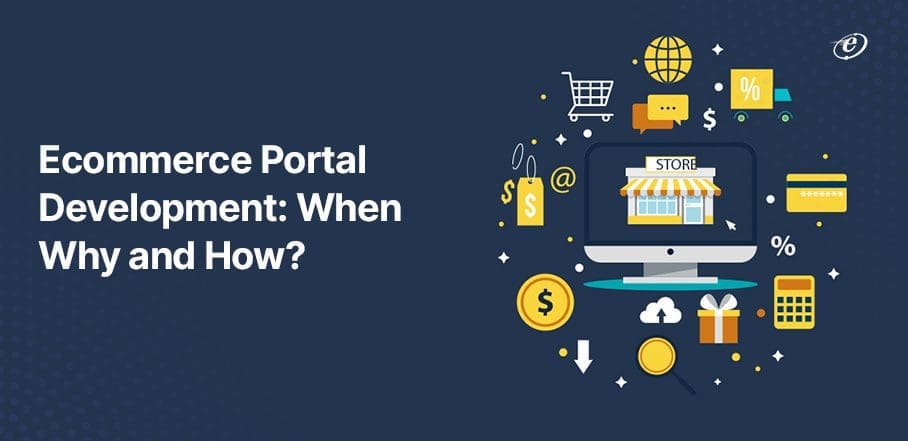
Ecommerce Portal Development: The Ultimate Guide
Synopsis: The ecommerce industry has experienced a tremendous development spurt over the last few years. Given the growing popularity of online shopping, businesses are apparently focused on e-commerce portals to satisfy increasing demand. This guide will help you comprehend how ecommerce portal development can increase the revenue of your business.
In the third quarter of 2022, approximately $265 billion in retail eCommerce sales in the US was recorded. The rise from the prior quarter is 3%. There might be various reasons behind this success. But numerous companies have noticed that ecommerce portal development lowers the cart abonnement rate and aids in retaining clients.
The business community has now recognized the portal solution as a chance to create and sustain customized and integrated e-commerce environments. Still, most of us are trying to understand why developing an e-commerce portal is necessary if we already have a functioning e-commerce website.
B2C or B2B portal development can significantly improve the growth of your business, even if you already have a website for selling goods and services online.
Let’s see how ecommerce web portal development is a promising strategy over just having an ecommerce website.
Ecommerce Portal vs Ecommerce Website
| Aspect | Ecommerce Portals | Ecommerce Websites |
| Definition | Multi-vendor marketplace connecting sellers and buyers. | Single business sells products directly. |
| Business Model | Earns through commissions or fees. | Revenue from individual sales. |
| Scalability | Highly scalable for more sellers. | Limited by the business’s capacity. |
| Customer Base | Broader customers reach multiple sellers. | Limited to the website owner’s base. |
| Maintenance | Requires management for fair competition. | Focus on the website’s performance. |
| Competition | High competition and varied choices. | Limited competition on business offerings. |
| Examples | Amazon, eBay, Alibaba, etc. | Nike’s online store, Apple Store, etc. |
The e-commerce website design and development companies help develop a robust portal that offers businesses a wide range of benefits. The main factor motivating enterprises to build portals for their ecommerce business is that these portals assist in lowering expenses by streamlining operations and minimizing the need for manual labo
This comprehensive guide on ecommerce portal development will assist you in determining why your ecommerce business needs to develop a web portal.
Let’s start with the basics!
What is Ecommerce Portal Development?
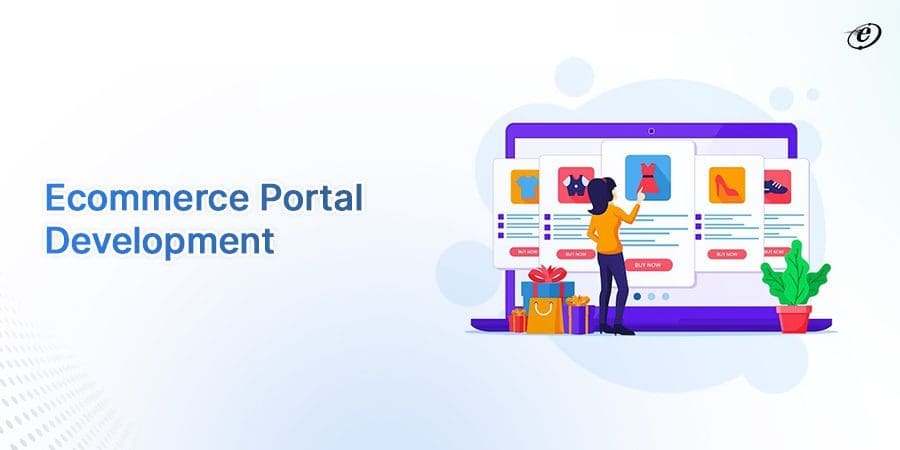
E-commerce portal development refers to creating and implementing online platforms that facilitate buying and selling products or services over the Internet. E-commerce portals, just like e-commerce websites, offer a convenient shopping experience, enabling businesses to reach a global audience and customers to browse, compare, and purchase items comfortably from their homes.
As compared to an ecommerce website, an ecommerce portal typically offers a more comprehensive and integrated platform, combining various services like
- online marketplace features,
- third-party vendor integration,
- advanced analytics.
This facilitates increased product exposure, access to a more extensive customer base, and enhanced operational efficiency. Hiring an ecommerce portal development company helps you adapt to market trends and capitalize on emerging opportunities, driving sustained growth and success for your eCommerce business.
Let’s understand with an example
A well-known ecommerce portal example is “Amazon”. It serves as a virtual marketplace, connecting multiple sellers and buyers worldwide. This e-commerce portal revolutionized online shopping, showcasing the power of a unified platform for diverse sellers and customers.
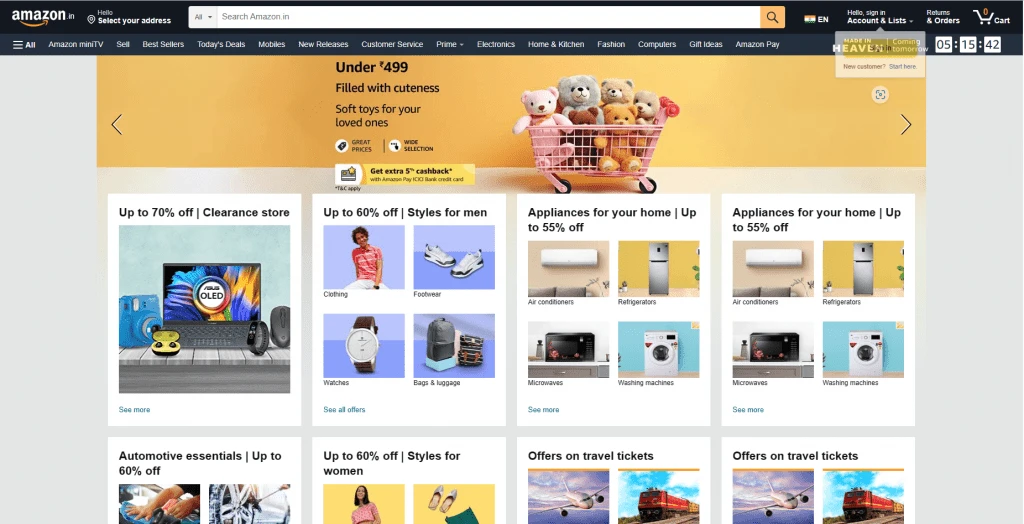
How is Amazon business growing with ecommerce portal development?
- Amazon provides a centralized platform, ensuring a seamless shopping experience and efficient order management.
- Through the portal, various vendors can list their products, set prices, and manage inventory, while customers can browse a vast array of items, read reviews, and make purchases.
- It manages shipping and payment processing, allowing merchants to reach a global audience and providing access to a wide variety of goods.
Some other leading ecommerce portal examples are Walmart, eBay, Alibaba, Flipkart, Shopify, and Etsy.
Types of Ecommerce Portals
Ecommerce portals come in various types, each catering to different business models and customer needs. Here are some of the common types of e-commerce portals:
| Type of Ecommerce Portal | Definition |
| Business-to-Business (B2B) | B2B portals facilitate transactions between businesses, allowing them to purchase goods or services from suppliers, wholesalers, or manufacturers. Example- Alibaba |
| Business-to-Commerce (B2C) | B2C portals are the most prevalent type and serve as online marketplaces where businesses directly sell products or services to individual consumers. Examples- Amazon, Walmart, Flipkart. |
| Consumer-to-Consumer (C2C) | C2C portals enable individuals to buy and sell products or services directly with each other. These platforms act as intermediaries, providing a secure environment for transactions. Example-eBay and Craigslist. |
| Mobile Commerce | M-commerce portals are optimized for mobile devices, allowing users to shop and transact through smartphones and tablets. Many e-commerce platforms have dedicated mobile apps. |
| Niche Portal | Niche portals focus on specific product categories, catering to a targeted audience. Examples include Etsy for handmade crafts and Zappos for footwear. |
| Dropshipping Portal | Dropshipping platforms connect retailers with suppliers, allowing retailers to sell products without keeping inventory. They forward orders to suppliers, who then ship products directly to customers. |
Ecommerce Portal Development: A Great Strategy for Your Business
Before developing a portal for your online store, you must know how these portals help elevate your business. Web portal development offers a transformative way for enterprises to thrive in the digital age, providing convenience and accessibility to consumers while driving growth, efficiency, and innovation in the business landscape.
Find the top benefits of developing an ecommerce portal for your enterprise.
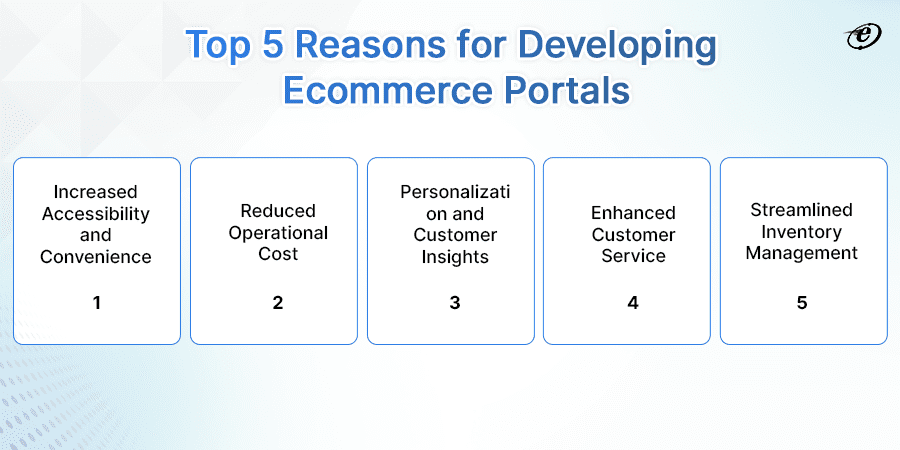
Reason 1: Increased Accessibility and Convenience
E-commerce portals provide 24/7 accessibility to products and services, enabling customers to shop at their convenience, regardless of time zones or business hours. The multilingual features integrated into portals help customers from other countries understand the content and make a purchase. This convenience factor enhances the overall shopping experience and encourages repeat purchases, fostering customer loyalty.
Reason 2: Reduced Operational Cost
With streamlined online operations, businesses can automate processes like inventory management, order fulfillment, and payment processing, decreasing costs and increasing operational efficiency.
Additionally, e-commerce platforms offer the option of drop shipping, allowing retailers to sell products without stocking inventory, further reducing upfront expenses.
Reason 3: Personalization and Customer Insights
E-commerce portals collect valuable customer data, such as browsing behavior, purchase history, and preferences. Analyzing customer insights enables businesses to make data-driven decisions and optimize their product offerings and promotions.
Custom web portals provide customers with self-service capabilities, carefully track their journey from product discovery to purchase, and frequently shorten the sales cycle.
Reason 4: Enhanced Customer Service
E-commerce portals provide multiple channels for customer support, such as live chat, email, and phone, enabling businesses to address customer inquiries promptly. Customers can also leave ratings and reviews, which serve as valuable feedback for other companies and potential buyers.
Reason 5: Streamlined Inventory Management
The e-commerce portal should be integrated with the company’s inventory management system to ensure real-time updates on product availability. When a customer places an order, the portal should automatically update the inventory levels, enabling better control over stock and preventing overselling. This minimizes the risk of overselling and stockouts, thus, improving operational efficiency.
Essential Features: Ecommerce Portal Development

An ecommerce portal development company adds various features to improve user experience and streamline the entire online shopping process. Key features of an ecommerce portal include:
Top Features of Ecommerce Portals
| Sr. No. | Features | Description |
| 1 | Inventory Management | These tools allow clients to place orders with a single click, check invoices, follow deliveries, and start return processes on e-commerce portals. Portal owners may simultaneously administer and manage loyalty programs, examine customer information and transactions, and optimize the entire order processing cycle. |
| 2 | User Account | Personalized user accounts enable customers to manage their information, track orders, view order history, and save payment preferences for future purchases. |
| 3 | Shopping Cart | An intuitive shopping cart system where customers can add products, review their selections, and proceed to the checkout process. A smooth and secure checkout experience is vital for reducing cart abandonment. |
| 4 | Order Tracking | The real-time order tracking and status notifications inform customers about their shipments’ progress or the time for delivery. |
| 5 | Search Option | Powerful search functionality and filtering options to help customers quickly find the products they are looking for based on various criteria like price range, brand, size, color, etc. |
| 6 | Chatbots | To help your customers rapidly discover the information they need and effectively resolve their problems, set up chatbots to respond to queries and direct users to pertinent portal sections. |
| 7 | Marketing Automation | By integrating marketing automation tools into ecommerce platforms, we can tailor offers, promotions, advertisements, and customer interactions depending on gathered customer information and behavioral trend analysis. |
| 8 | Customer Support | For the customers, customer assistance acts as a pillar of reliability and confidence. It is crucial that clients can easily contact the support staff via phone, chat, email, or other means. |
| 9 | Reporting | In-depth analytics and reporting features provide insights into sales performance, customer behavior, popular products, and other key metrics. Businesses can use this information to optimize their strategy and make well-informed decisions. |
| 10 | Payment Gateway | Integrate with a trusted and secure payment gateway to facilitate smooth and secure transactions. Make sure to support multiple payment methods, such as credit/debit cards, digital wallets, and online banking. |
| 11 | Discount or Promotions | Applying discounts, coupon codes, loyalty programs, and promotional offers to your portal attracts more and more customers and drives sales. |
| 12 | Content Management | To produce and arrange product/service descriptions, catalogs, and knowledge base materials without coding, incorporate simple content management systems. |
Learn to Integrate Ecommerce Portals into Your Corporate Workflow
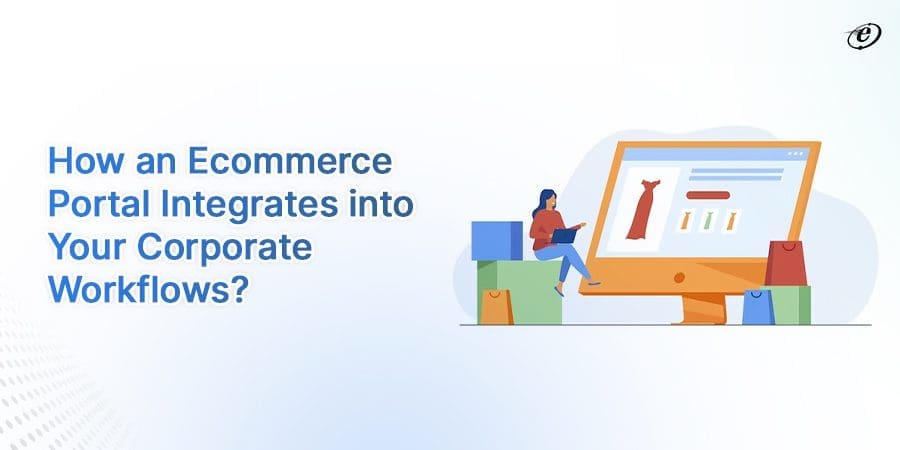
Integrating an ecommerce portal into corporate workflows is crucial for seamless operations and maximizing business efficiency. Here are some key aspects of how an ecommerce web portal can incorporate into your corporate workflows:
-
Inventory and Order Management
The ecommerce portal should be integrated with the company’s inventory management system to ensure real-time updates on product availability.
Benefit: This integration streamlines the order fulfillment process, reducing manual work and potential errors
-
Accounting and Finance
Integration with the company’s accounting and finance systems allows for automated invoicing, payment processing, and tracking of financial transactions.
Benefit: This ensures timely and accurate payment processing and helps maintain financial records.
-
Customer Relationship Management (CRM)
Integrating the ecommerce portal with the CRM system allows businesses to track customer interactions, monitor buying behavior, and offer personalized marketing campaigns.
Benefit: It helps in building stronger customer relationships and improving customer retention.
-
Shipping and Logistics
Integration with shipping and logistics partners enables automatic order processing and shipping label generation.
Benefit: It provides real-time tracking information to customers and optimizes shipping costs and delivery times.
-
Marketing and Analytics
Integrating the portal with marketing and analytics tools enables businesses to track website traffic, monitor conversion rates, and analyze user behavior.
Benefit: This data helps optimize marketing strategies and improve the overall user experience.
-
Enterprise Resource Planning (ERP)
Integrating with the ERP system streamlines data flow between departments, such as finance, sales, and inventory management.
Benefit: It ensures that all teams have access to up-to-date information for better decision-making.
Let’s move on to discover all the steps involved in developing ecommerce portals.
Effective Step-by-Step Guide on Ecommerce Portal Development
Ecommerce web portal development is a comprehensive process that requires careful planning and execution. A leading web portal development company involves several stages to create a functional and user-friendly online shopping platform. Here are the essential steps involved in successfully developing ecommerce portals.
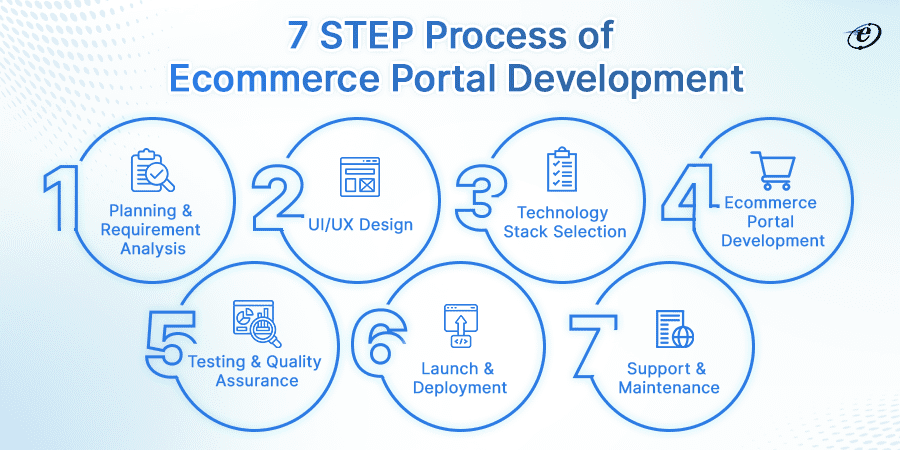
1. Planning and Requirement Analysis
The first phase is crucial for understanding the project’s scope, objectives, and target audience.
What do you need to do?
- Gather detailed requirements from stakeholders, including business goals, desired features, budget constraints, and timeline.
- Conduct thorough research to identify industry trends, customer preferences, and potential competitors.
- Analyzing successful ecommerce portals in the same niche can provide valuable insights and inspiration.
2. UI/UX Design
After understanding your requirement for a portal, the next step is to create a user-friendly and visually appealing design that aligns with the brand’s identity and provides excellent user experience.
Some important factors to consider are:
- Intuitive navigation
- Responsive design for mobile devices
- Clear calls to action.
3. Technology Stack Selection
Choose the appropriate technology stack, including programming languages, frameworks, and database systems. The selection should be based on certain points.
Here are some key points to help you make the right choice
- Understand your requirements
- Consider scalability
- Development team expertise
- Performance and speed check
- Integration Capabilities
- Flexibility & Customization
- Mobile responsiveness
Read our blog on how to choose the right web portal development framework in 2023.
4. Portal Development
Once techstack is selected, the dedicated ecommerce portal developer starts writing code. They must consider several factors to create a successful and error-free web gateway.
Here is an essential checklist for robust ecommerce web portal development
- Convert the approved design into a functional front-end interface using HTML, CSS, and JavaScript.
- Focus on building responsive, interactive, and visually appealing web pages.
- Develop the backend infrastructure for handling data processing, user authentication, and order management.
- Choose a robust server-side language and framework to ensure security and performance.
- Integrate essential ecommerce features, such as product catalog management, shopping cart, secure payment gateway, order processing, and inventory management.
- Create a well-structured database to store product information, customer data, orders, and other relevant information.
- Put in place robust security measures to safeguard user data and stop illegal access.
- Use SSL certificates, encryption, and secure authentication protocols to safeguard sensitive information.
- Implement SEO best practices during development to ensure the website ranks well on search engines.
- Integrate marketing tools and analytics to track user behavior and website performance.
5. Testing & Quality Assurance
Conduct comprehensive testing to identify and fix all bugs or issues. Perform unit, integration, and user acceptance testing (UAT) to ensure the website functions flawlessly.
6. Launch and Deployment
Prepare the website for the public launch by setting up hosting, domain, and server configurations. Test the entire system once more before making it live.
7. Support and Maintenance
After the launch, provide ongoing support, bug fixing, and regular updates to enhance the website’s performance and address any emerging issues. Besides this, continuously monitor website performance and optimize loading speed to provide users with a seamless and fast shopping experience.
Note *The collaboration between developers, designers, project managers, and stakeholders throughout the web portal development process is essential to ensure the successful delivery of a high-quality and competitive online shopping platform. Additionally, it is crucial to gather user feedback and make iterative improvements based on their needs and preferences.
Custom Ecommerce Portal Development Challenges and How to Overcome Them: Tips from Experts
Web portal development is not as easy as it seems. It involves various challenges. Addressing these challenges with proactive planning, skilled development, adherence to best practices, and continuous optimization, ecommerce businesses can create a secure, user-friendly, and scalable portal that meets customer expectations and drives business growth.
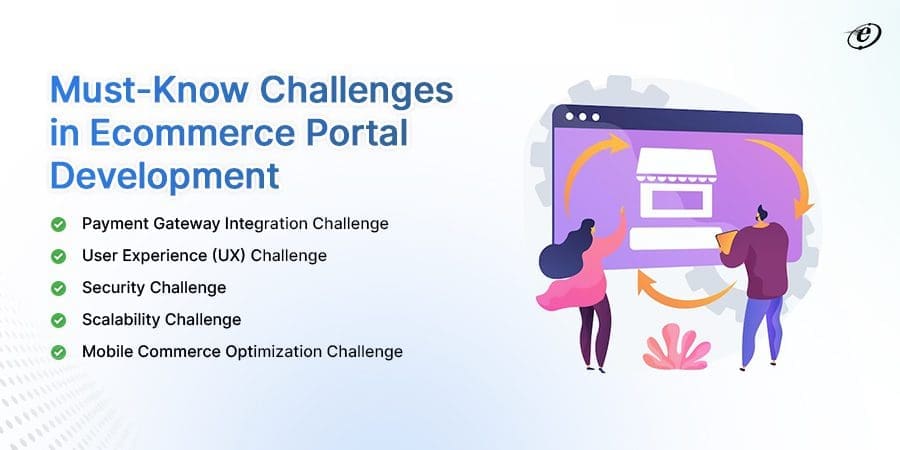
The top 5 challenges in developing an ecommerce portal and their solutions are as follows:
-
Payment Gateway Integration Challenge
Integrating multiple payment gateways to offer diverse payment options while ensuring security and compliance.
Solution: Choose reputable payment gateways, work closely with their APIs, and adhere to regional payment regulations.
-
User Experience (UX) Challenge
Providing a seamless and user-friendly shopping experience to enhance customer satisfaction and increase conversion rates.
Solution: Conduct thorough UX research, optimize website performance, streamline navigation, and ensure responsive design for all devices.
-
Security Challenge
Protecting customer data and financial transactions from cyber threats and hacking.
Solution: Implement robust security measures, use SSL certificates, encrypt sensitive data, and regularly update security protocols to safeguard against potential breaches.
-
Scalability Challenge
Ensuring the ecommerce portal can handle increased traffic and transactions as the business grows.
Solution: Plan for scalability from the start, choose a scalable technology stack, use cloud-based hosting services, and regularly monitor and optimize server performance.
-
Mobile Commerce Optimization Challenge
Optimizing the ecommerce portal for mobile devices to cater to the rising number of mobile shoppers.
Solution: Adopt a mobile-first approach, design a responsive and mobile-friendly interface, and conduct extensive testing on various mobile devices to ensure a smooth user experience.
Learn the significance of responsive design in web portal development.
Find the Cost of Ecommerce Portal Development in 2024
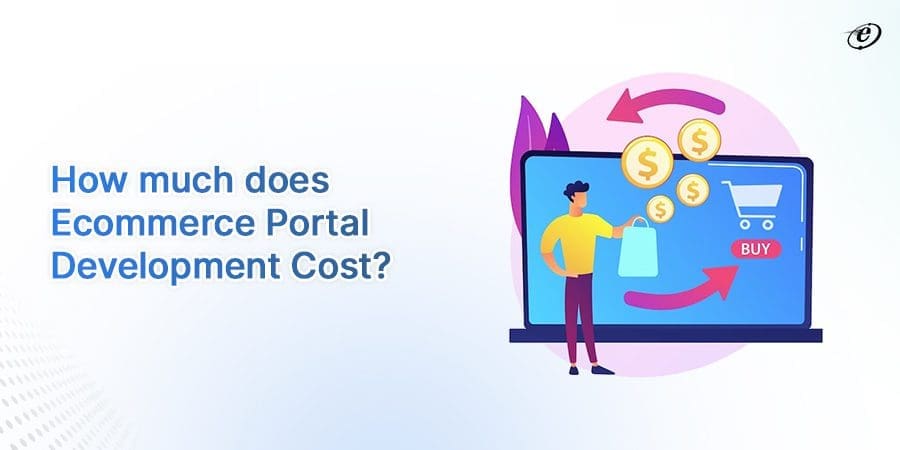
On average, a basic ecommerce portal development may cost anywhere from $10,000 to $50,000. However, the cost can range from $50,000 to $200,000 or more for more complex and feature-rich portals.
The average cost of portal development can vary widely depending on factors such as
- Complexity of the project
- Features required
- Technology stack chosen
- Size of the development team
- Location of the development company
The cost varies from country to country, with the lowest in countries like India. That’s why businesses across the world outsource developers or development teams from India to reduce project costs.
Ecommerce Portal Development Cost in Different Countries
| Country | Average Development Cost |
| USA | $10,000-$120,000+ |
| India | $4,000-$50,000+ |
| UK | $8,000-$90,000+ |
| Australia | $9,000-$150,000+ |
| Philippines | $4,000-$50,000+ |
Note* For a more precise quotation based on your unique requirements, it is essential to obtain comprehensive project bids from many development companies.
Ecommerce Portal Development in Right Hand!
Web portal development for ecommerce stores enables companies to have a strong online presence, connect with a large audience, and benefit from the expanding online shopping trend. It offers a scalable platform to showcase products, facilitate secure transactions, and provide a seamless shopping experience, resulting in increased sales and business growth.
Find the top 10 web portal development trends in 2023 & beyond.
So, if you are ready to develop a feature-rich and user-friendly portal for your ecommerce business, contact the eLuminous team. eluminous Technologies is a leading web portal development company that ensures robust portal development due to its expertise and experience in building complex and feature-rich portals.
The professional web portal development team at eLuminous deeply understands the latest technologies, security protocols, and user experience trends. They can tailor the portal to meet specific business needs, ensure seamless integration with various systems, and provide ongoing support and maintenance.
Get an instant quote for your project!
Frequently Asked Questions: Ecommerce Portal Development
How can I build an eCommerce platform?
To develop a robust platform, you need to go a strategic way. Start by defining your requirements, selecting a suitable platform or technology stack, designing an intuitive user interface, integrating payment gateways and shipping solutions, implementing security measures, and testing thoroughly before launch. Consider hiring experienced developers or agencies for assistance.
What is the portal model in eCommerce?
The portal model in eCommerce refers to a platform that serves as a gateway to various sellers, offering a wide range of products or services. It aggregates offerings from multiple vendors, providing customers with a diverse selection and often facilitating transactions through the portal.



